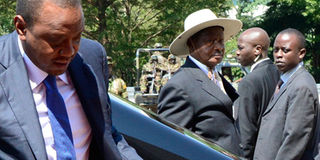Cracks emerge in Uganda-Kenya oil pipeline deal

President Museveni receives Kenya’s president Uhuru Kenyatta (L) last year. File photo
What you need to know:
Differing. Members of the Kenyan delegation say there are issues to which they cannot agree until they receive communication from home
KAMPALA.
Within hours of President Museveni and his Kenyan counterpart Uhuru Kenyatta’s agreement on the “least” cost Northern route for a joint crude oil export pipeline, cracks started emerging in the deal with Kenya contesting some of the pre-conditions set by Uganda, Daily Monitor has learnt.
A delegation that travelled with President Kenyatta during his three-day visit to Uganda, expressed concern on Monday over some of the conditions for the Shs17 trillion ($4.5 billion) oil infrastructure project during a meeting with Uganda's Energy minister Irene Muloni. The meeting was held at State House Entebbe immediately after the joint press conference by the two heads of state.
One of the conditions Kenya is contesting is guaranteeing upfront financing to the project and the attendant infrastructures, while the other is guaranteeing transit fees/tariffs not higher than any of the alternative routes which is still under discussion with the technical team back in Kenya.
Ms Muloni in an interview on Tuesday admitted that the Kenyan delegation contested some of the terms but added the cracks had been unplugged during the ensuing discussions. She described the divergence in opinions as a “case of misinterpretation” largely hinged on the wording in the communiqué that was read out.
“It is not like it was a misunderstanding but rather they were uncomfortable with some of the terms. The issue of financing was premature before we agree on the structure of the project in terms of ownership,” Ms Muloni said.
“But since we have now agreed to have the pipeline via the Northern route, technical teams from both sides will continue looking at all points detailing financing. Feasibilities for the project have been completed. Once we finish discussions on the structure, we will move into tendering and other processes at a later stage,” she added.
The pipeline
The 1,500km pipeline will run from Hoima through Lake Kyoga, northeast Uganda to Kenya’s Lokichar basin and later connect to the Lamu port at the coast. The feasibility studies for the project were conducted by Toyota Tsusho, a consulting and automobile Japanese firm and reports were submitted to both governments.
Ms Muloni further explained that since it is a joint project, they are trying to court neigbouring Rwanda (which is trying to develop capacity to exploit its methane gas reserves estimated at 55 billion cubic metres) and if possible DR Congo (which has vast hydrocarbon reserves) adjacent to Uganda’s Albertine Graben border line in the Southwest.
In comparison
Currently, Uganda’s oil volumes stand at 6.5 billion barrels from the 40 per cent acreage explored so far. However, these could hit the 8 billion barrels mark soon with additional discoveries. Kenya, on the other hand, in the early stages of exploration has confirmed only 600 million barrels.
The crude export pipeline is being advocated by the International Oil Companies-UK’s Tullow Oil PLC, France’s Total E&P and China’s Cnooc currently operating in Uganda. The infrastructure will supplement the 30,000 bpd oil refinery that government is seeking. The greenfield refinery, whose tender, has been awarded RT Global Resources, a consortium led by Russia’s Rostec, a defence and technology corporation, is also estimated to cost Shs15 trillion ($4b).
According to other terms under the pipeline project, Kenya will have to guarantee security on its side of the border, especially in the restive Turkana region where its oil deposits are located, and also guarantee expeditious implementation of the project.
Differing communiques
Asked by this newspaper on Monday about the rationale for the pipeline, President Museveni said the issue of the pipeline is not about what Kenya decides. “Implementation will go on because they have already agreed with the IOCs. What we had to do first was to agree on the least cost route, then we can go into other discussions,” Mr Museveni said.
Kenya and Uganda have since put out communiqués regarding the matter but they largely differ in content. A statement issued by the Kenyan presidency does not include the pre-conditions which are contained in Uganda’s version.
A joint harmonised communiqué is not yet out pending further discussions on the matter.
The contention
• Guaranteeing upfront financing to the project and the attendant infrastructures.
• Guaranteeing transit fees/tariffs not higher than any of the alternative routes.



